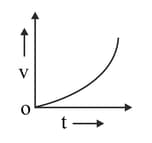A spacecraft is flying in a straight path and it has a velocity of fires its rocket motors for . At the end of this time, its velocity increases and becomes Find the distance travelled by the spacecraft in the first after the motors were started? The motors were in action for only .
Important Questions on Motion
Three particles A, B and C are thrown from top of a building with same speed. A is thrown upwards, B is thrown downwards and C is thrown horizontally, they hit the ground with speed , and respectively then
A particle starts its motion from rest under the action of a constant force. If the distance covered in first 10 seconds is S1 and that covered in next 10 seconds is S2 then
The velocity – time graph of a moving body is shown in the figure. Which of the following statements is true?

(i) the maximum height to which it rises,
(ii) the total time it takes to return to the surface of the earth.
A body is projected vertically upward direction with a speed . Find the (a) time taken (b) distance travelled by the body in reaching its topmost point.
Derive third equation of motion by graphical method.
Match the first column with appropriate entries in the second and third columns and remake the table.
| S. No. | Column 1 | Column 2 | Column 3 |
| 1 | Negative acceleration | The velocity of the object remains constant | A car, initially at rest reaches a velocity of in seconds |
| 2 | Positive acceleration | The velocity of the object decreases | A vehicle is moving with a velocity of |
| 3 | Zero acceleration | The velocity of the object increases | A vehicle moving with the velocity , stops after seconds |

